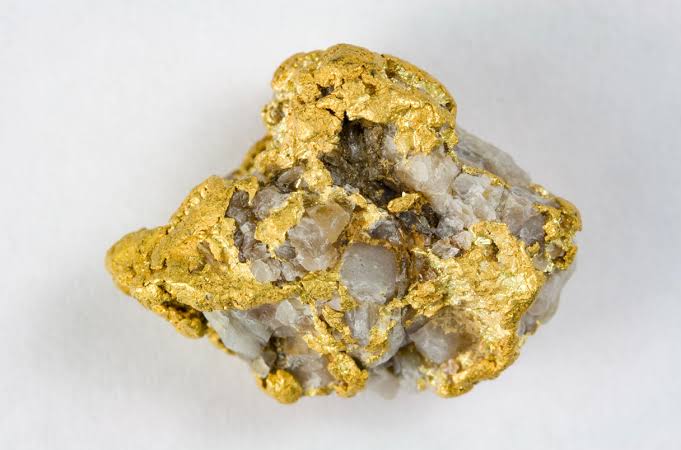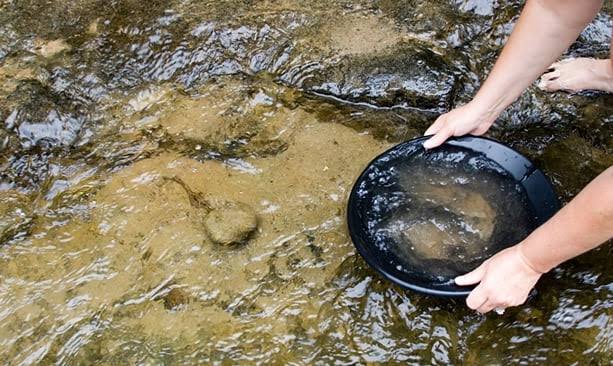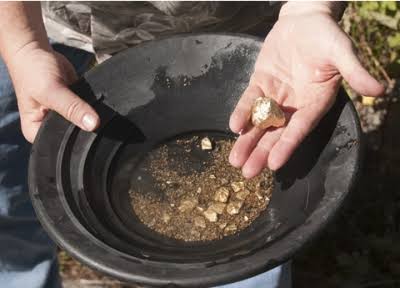Hidden in Stone: Discover the Surprising Rocks That Harbor Gold

Gold has fascinated humans for thousands of years. From ancient civilizations that crafted jewelry and coins to modern miners who search remote mountains, gold has always represented wealth, beauty, and mystery. But one question still excites rockhounds and prospectors alike: where does gold actually come from, and what types of rocks contain it?
When most people think of finding gold, they imagine panning in a river or spotting a shiny nugget on the ground. While that does happen, it's only part of the story. Gold is often locked away in rocks deep beneath the surface, formed through geological processes that took place millions of years ago. To understand how and where to look for it, we need to explore the kinds of rocks that host this precious metal, the conditions that create deposits, and how rockhounds can identify potential gold-bearing sites.
This article takes you through the science in plain English. We'll talk about how gold ends up in rocks, the main types of rocks that contain it, and how you can recognize these rocks in the field. We'll also look at famous gold deposits around the world and share tips for anyone who wants to go rockhounding for gold responsibly.
How Gold Gets Into Rocks
Before we talk about the specific rocks, it helps to understand how gold actually gets there. Gold doesn't just appear randomly; it's transported and deposited by natural processes over long spans of time. The main process is something geologists call hydrothermal activity.
Deep underground, hot fluids rich in minerals move through cracks and fractures in the Earth's crust. These fluids carry dissolved metals, including gold. When the fluids cool down or encounter changes in pressure, the gold drops out and gets trapped in the surrounding rocks. Over millions of years, this can form veins, small inclusions, or even large-scale ore deposits.
Gold can also accumulate in riverbeds and other sedimentary environments. As rocks containing gold break down through weathering, the heavier gold particles wash downstream and settle in low spots where water slows down. That's how placer deposits form—the source of many nuggets found by panners.
In short, gold ends up in rocks through two main paths:
- Being locked into the rock itself during hydrothermal or geological processes.
- Being concentrated by erosion and transport into sediments.
Knowing this helps us understand why certain rocks are far more likely to contain gold than others.
Quartz Veins in Igneous and Metamorphic Rocks
If you've ever seen a piece of quartz shot through with tiny golden specks, you've already met one of the most common hosts of gold: quartz veins. Quartz is a hard, glassy mineral made of silica, and it often forms when hot, mineral-rich fluids cool and crystallize in fractures. These fluids are the same ones that can carry gold, so quartz veins are natural traps for gold deposition.
Many of the world's classic gold districts, from California's Mother Lode to Australia's goldfields, are famous for their quartz-gold relationships. Gold in quartz can appear in two main ways. Sometimes you can actually see visible "free gold" as small flakes or even nuggets nestled in the quartz. Other times, the gold is microscopic, trapped inside sulfide minerals like pyrite ("fool's gold"), arsenopyrite, or chalcopyrite that are mixed with the quartz.
Gold-bearing quartz veins are most often found in igneous rocks like granite and rhyolite, or in metamorphic rocks like schist and slate. These rocks provide the fractures and the geological environments where hydrothermal fluids can move and deposit minerals. For rockhounds, seeing quartz veins cutting through darker host rock can be a sign worth investigating.
Sedimentary Hosts: Carlin-Type and Placer Deposits
While quartz veins are probably the most famous gold host, sedimentary rocks also play an important role. In Nevada, for example, a huge amount of gold is found in what geologists call Carlin-type deposits. These deposits don't usually contain visible gold; instead, the gold is present as tiny particles dispersed within pyrite and other sulfide minerals in carbonate rocks like limestone and dolomite.
Carlin-type deposits form when hot, chemically active fluids move through sedimentary basins. Instead of depositing large nuggets, they leave behind microscopic gold that's often invisible to the naked eye. Nevada's Carlin Trend is one of the world's richest gold-producing regions because of this unusual process.
On the other end of the spectrum are placer deposits, which are probably the most familiar to amateur prospectors. Placer deposits form when gold erodes out of primary rocks (like quartz veins) and gets transported by water. Because gold is heavy, it tends to settle in places where the current slows down, such as bends in rivers, cracks in bedrock, or behind large rocks. Over time, these accumulations can become rich enough to mine.
There are different kinds of placer deposits:
- Alluvial placers in active rivers and streams.
- Eluvial placers, where gold accumulates downslope of its original source.
- Paleo-placers, which are ancient riverbeds now buried by other rock layers.
One of the most famous paleo-placer deposits is South Africa's Witwatersrand Basin, which has produced more gold than any other region in history.
Hydrothermal Systems: Orogenic and Skarn Deposits
Another major group of gold-bearing rocks are those associated with hydrothermal systems. These include orogenic gold deposits, which form along fault zones during mountain-building events, and skarn deposits, which form where hot fluids from an intrusion react with carbonate rocks like limestone.
In orogenic deposits, gold is usually found in quartz-carbonate veins together with sulfide minerals. These veins often cut across metamorphic rocks that have been highly deformed by tectonic forces. Orogenic deposits are a global phenomenon and have provided much of the world's lode gold.
Skarn deposits are a bit different. They occur where igneous intrusions, like granite bodies, come into contact with carbonate rocks. The heat and fluids from the intrusion cause chemical reactions that produce new minerals, and gold can be concentrated in the altered zones. Skarns are often associated with copper and other metals, but some can be surprisingly rich in gold.
Both types of deposits highlight the role of hot, mineral-rich fluids and the right geological conditions. Without fractures, reactive host rocks, and the right chemistry, the gold would never be deposited in concentrated amounts.

Other Mineral Associations
Gold doesn't always travel alone. It often appears alongside other minerals that can act as clues for prospectors. Common companions include quartz, carbonates like calcite, and sulfides such as pyrite and arsenopyrite. In some cases, gold is linked with tellurides (minerals combining gold with tellurium), stibnite (antimony sulfide), or fahlore (a group of copper-antimony-sulfide minerals).
While these minerals don't guarantee gold, their presence can suggest that the geological system had the right conditions to concentrate it. Experienced rockhounds often learn to read these mineral "signatures" in the field.
How to Identify Gold-Bearing Rocks in the Field
For hobbyists and rockhounds, the challenge is figuring out whether a rock might actually contain gold. While laboratory testing provides the most reliable results, there are some field clues to watch for.
Quartz veins cutting through other rocks are always worth a look, especially if they show signs of iron staining (a rusty color) from sulfide minerals breaking down. Areas near old faults or shear zones can also be promising, since these structures often guided the flow of gold-bearing fluids.
If you're panning in a stream, heavy black sands made of magnetite and other dense minerals can signal good conditions for placer gold. Gold itself is distinctively heavy, soft, and malleable compared to pyrite or mica, which can look similar but behave differently when tested.
For more serious prospecting, geologists often use hand lenses, streak plates, or even acid tests to check minerals. But for casual rockhounds, the main thing is learning what promising rocks look like and knowing where to look for them.
Famous Gold Deposits Around the World
To see these principles in action, let's look at a few real-world examples.
The Mother Lode region of California is a classic case of quartz veins rich in gold. During the Gold Rush of the 1800s, prospectors followed these veins for miles, uncovering a network of lodes that fueled a historic boom.
In Nevada, the Carlin Trend illustrates sediment-hosted gold. Instead of nuggets, miners extract microscopic gold invisible to the naked eye. This type of deposit has made Nevada one of the top gold producers in the world.
Meanwhile, South Africa's Witwatersrand Basin shows the power of placer deposits. These ancient riverbeds, now buried beneath layers of rock, have yielded more gold than any other single location on Earth.
Each of these examples highlights how gold can occur in very different geological settings, from quartz veins to sedimentary basins to ancient river deposits.
Tips for Rockhounding Enthusiasts

If you're interested in looking for gold yourself, start by studying the geology of your region. Local rockhounding clubs, geological surveys, or even old mining reports can point you toward areas with a history of gold occurrence. Look for places with quartz veins, fault zones, or old placer workings.
When prospecting, always make sure you understand the rules. Some areas are private property, others are protected lands where collecting is prohibited. There are also safety considerations, especially around abandoned mines or unstable rock outcrops.
The best approach is to treat gold hunting as an adventure and a learning experience. Even if you don't strike it rich, you'll gain knowledge about geology and enjoy the excitement of discovery. Many rockhounds find that the real reward is the connection with nature and the thrill of uncovering hidden stories in stone.
Pulling It All Together
So, what types of rocks contain gold? The answer is diverse. Gold hides in quartz veins within igneous and metamorphic rocks, in microscopic form within sedimentary basins, in river gravels as placer deposits, and in hydrothermal systems like orogenic and skarn deposits. It can appear alongside sulfide minerals, in association with tellurides or carbonates, or locked away in ancient riverbeds.
For rockhounds, knowing these rock types isn't just about science—it's about adventure. Each outcrop or streambed offers the chance of discovery. And while not every rock will sparkle with gold, learning to read the signs can make the hunt all the more rewarding.
Gold may be hidden in stone, but with knowledge, patience, and a keen eye, you can begin to uncover its secrets.
Perfect idea 👌 — an FAQ section can capture high-intent search queries that people type into Google but aren’t fully answered in the main article. This improves SEO, ranking, and snippet opportunities. Below is a strong FAQ section written in a conversational, reader-friendly style:
Frequently Asked Questions About Rocks That Contain Gold
1. Can you find gold in any type of rock?
+No, gold isn't evenly spread across all rocks. It's concentrated in specific geological environments, such as quartz veins in igneous and metamorphic rocks, sedimentary deposits like the Carlin Trend, and placer deposits in riverbeds. While trace amounts of gold exist in many rocks, only certain rock types contain enough to be of interest to rockhounds or miners.
2. How can you tell if a rock has real gold or just "fool's gold"?
+The biggest look-alike is pyrite, also called fool's gold. Unlike real gold, pyrite forms sharp, cube-like crystals and is brittle—it will shatter if struck. Gold, on the other hand, is soft and malleable; you can flatten it with a hammer without breaking it. Gold also has a warm yellow color that doesn't tarnish, while pyrite can look brassy or develop a dull surface over time.
3. Is gold always visible in gold-bearing rocks?
+Not always. Some deposits, especially Carlin-type deposits in Nevada, contain gold that's microscopic and invisible to the naked eye. In these rocks, gold occurs as tiny particles locked within sulfide minerals. In other cases, such as quartz veins, gold may appear as visible flakes or even nuggets.
4. What is the easiest rock type for beginners to look for when hunting gold?
+For most beginners, quartz veins are the best starting point. They're relatively easy to spot in the field—white or glassy streaks cutting through darker host rocks—and have a strong historical association with gold. Streams draining from areas with quartz veins are also great places to check for placer gold.
5. Do metamorphic rocks contain gold?
+Yes. Metamorphic rocks like schist and slate often host gold-bearing quartz veins, especially in regions where mountain-building has created fault zones and fractures. Many famous "orogenic" gold deposits are found in metamorphic belts formed during tectonic collisions.
6. Can gold be found in volcanic rocks?
+Absolutely. Volcanic rocks such as rhyolite and basalt can contain gold, especially when they've been fractured and filled with quartz veins. Hydrothermal systems linked to volcanic activity often transport and deposit gold. Some epithermal gold deposits, for example, are directly tied to ancient volcanic systems.
7. Where is the best place to search for placer gold?
+Placer gold is most often found in streambeds where water slows down. Look in cracks in bedrock, behind large rocks, inside bends of rivers, or at the base of waterfalls. These natural traps allow heavy gold particles to settle while lighter materials wash away.
8. Is it legal to collect rocks that contain gold?
+It depends on where you're searching. On private land, you'll need the owner's permission. On public land, rules vary—some areas allow recreational panning or rock collecting, while others are off-limits to protect natural resources. Always check local regulations before collecting, and never dig or pan in restricted or protected areas.
9. Can you extract gold from rocks at home?
+While it's technically possible, it's rarely practical or safe. Gold locked inside sulfide minerals or microscopic grains requires specialized equipment and chemical processes to extract. Crushing and panning quartz for visible free gold is something hobbyists can try on a small scale, but large-scale extraction should be left to professionals.
10. Why is gold so often associated with quartz?
+Quartz forms from the same hydrothermal fluids that carry gold. As these hot, mineral-rich fluids move through fractures in the Earth's crust, quartz crystallizes out—and gold often precipitates at the same time. This is why quartz veins are one of the strongest indicators of possible gold mineralization.
